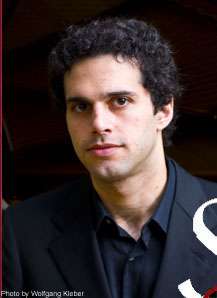|
Back
Lightness and gravity New York
Merkin Concert Hall
09/03/2013 -
Johannes Brahms: Four Capriccios from Klavierstücke, Op. 76
Ludwig van Beethoven: Sonata No. 16 in G Major, Opus 31, No. 1
Michael Hersch: Tenebrae – Two Lullabies (New York Premieres)
Sergei Rachmaninoff: Sonata No. 2 in B-flat minor, Opus 36 (Original 1913 version)
Soheil Nasseri (Pianist) 
S. Nasseri (© Wolfgang Kleber)
A recital by Soheil Nasseri is always an ebullient affair. The still young artist is not idiosyncratic, but his attacks are always adventurous, his intensity can be almost overwhelming, and his digits obviously know what they are doing, even in the most complex music.
Last night at Merkin Hall, it took a while to warm up, but the final four works had a spaciousness, gravity, and the performance of a thoroughbred.
In fact, next to Beethoven’s light comfortable early Sonata, Sergei Rachmaninoff’s Second Sonata, which ended the program, was offered with a palette of endless inspiration.
Mr. Nasseri quite rightly chose the longer original version of the Sonata, which was later chopped up by the composer. Rachmaninoff had decided that 25 minutes was longer than Chopin’s Second Sonata, so he brought his own down to 19 minutes. I listened to both versions over the weekend, and the difference was palpable. Imagine Harold Pinter without the pauses, or Moby Dick excising those chapters which detail how to make a harpoon or planking on the boat. They still have a drama–but those extras, ungainly as they may seem, give us time to catch our breaths before going onto the next scenes.
This 1913 Rachmaninoff is a bit ungainly, but with the right pianist, one doesn’t worry about the structure. The sounds themselves are sufficient.
The opening might be marked Allegro agitato, but Mr. Nasseri had no use for gratuitous pyrotechnics. Rather, he gave it the authority to make the movement a stately affair, following this with a most noble slow movement. The opening of the finale is inevitably blurred (actually, Horowitz’ version manages to avoid this), but after that Mr. Nasseri played with care and depth.
So much depth that I prayed no encore would follow. And the pianist had the artistry to know that nothing could follow it.
The preceding three works were by Michael Hersch, whose music is performed frequently by the pianist. These three were described by the composer as picturing the desolation he felt when his closest friend died from ovarian cancer.
The works were indeed desolate, each starting (and remaining) in the darkest deep keys. Both the Tenebrae and the two Lullabies had different dominant themes–the first a two-note motive like the opening of Stravinsky’s Symphony of Psalms, the other two with a chorale and a Chopin-like nocturne opening.
But marking this whole trio were spasmodic chords–I mean literal spasms–on the piano. These were sudden dissonant harsh chords interrupting the elegiac chorale or the highly complex developments in the first and third works. The chords literally stamped out the feelings we all have upon the loss of a loved one. “Why? Why? Why??”
Yet their very frequency, while heartfelt, poignant, worthy of this fine composer, soon lost its effect. One understands and respects the pangs he must have felt. Yet to follow this with the Rachmaninoff was like following a photograph of a tragedy with a Renaissance painting.
The opening works were the four Capriccios from Brahms’ Opus 76 Klavierstücke. Three were performed with great refinement, and the second, the jaunty Allegro non troppo, was given virtually a skittish treatment which was absolutely delightful.
That Beethoven had a peculiar start, since Mr. Nasseri somehow missed those 16th-note delays on the chords. It is the second movement, though, where Beethoven excelled, where he turned a congenial showpiece into a virtual jewel. Soheil Nasseri was not only up to the task, but he demonstrated his potential for becoming a genuinely illustrious artist.
Harry Rolnick
|